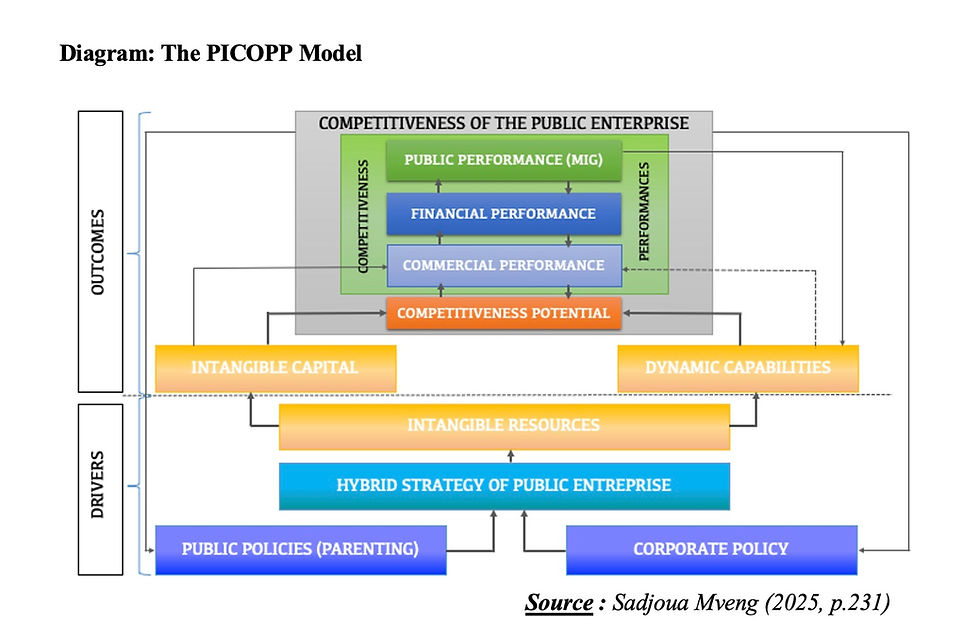How to steer competitiveness in public enterprises?
- Business Science Institute

- 13. Juli 2025
- 3 Min. Lesezeit

Doctor Joseph Lottin SADJOUA MVENG
DBA Douala-3, Cameroun
Business Science Institute
Introduction
Within the framework of the policy to restore market mechanisms implemented in Cameroon since 1990, some historic public enterprises whose privatization processes were unsuccessful now find themselves competing with private companies that have been granted operational concessions in the same markets. While this phenomenon has endured over time, it has yet to be the subject of applied research. This study seeks to understand how these public enterprises steer their competitiveness in an environment they were not originally designed for. This DBA research aims to improve the practices of such public organizations.
Impact(s) de la recherche
The impact of this study is observable at two levels. On a managerial level, it proposes the PICOPP model—an acronym for Piloting Competitiveness in Public Power Organizations (see diagram below). This management tool, inspired by the experience of CAMTEL, the historical public telecommunications operator in Cameroon, formalizes the practices of public enterprises in this area and incorporates theoretical elements designed to optimize outcomes. Based on a hybrid strategy, it builds intangible resources that emit a tonic potential for competitiveness, aiming to produce sustainable performance. This is the first model of its kind for steering the competitiveness of public enterprises in Cameroon. It addresses two concrete needs: providing public managers with a suitable tool to ensure their enterprises’ competitiveness according to their assigned objectives, and equipping national competitiveness monitoring bodies with a reliable instrument to assess the competitiveness level of each public enterprise.

On the theoretical level, this research contributes to structuring a specific theoretical field for studying how public enterprises manage competitiveness. It connects three disciplines: management control, strategic management, and public management. It proposes a new theoretical approach by combining within a single tool the contextualized dimensions of the concepts of “competitiveness potential”—comprising intangible capital and dynamic capabilities—and “competitiveness performance”—including commercial, financial, and public-interest performance. Through this operationalization, it constructs a synthetic index to measure the competitiveness level of public enterprises.
Research Foundations
The theoretical framework of this reflection is a construct of theories drawn from three management science disciplines. From management control, it draws on the pragmatic and semiotic theories of management tools, especially the theory of tool appropriation (De Vaujany, 2006), given the flexibility of control instruments in enterprises. From strategic management, it incorporates the resource-based view, particularly approaches based on intangible capital (Ternisien and Diguet, 2001) and dynamic capabilities (Azura and Siti, 2013), due to the relevance of these competitiveness factors. From public management, it combines the theory of public value and the theory of normative “publicness” through the approach of “public management as the management of public authority” (Zampiccoli, 2011), which aligns both internal and external goals with the competitiveness objectives assigned to public enterprises in the Cameroonian context.
Methodology
The adopted epistemological paradigm is radical pragmatic constructivism, within a contextualist analytical framework. Methodologically, it is a qualitative case study applied to CAMTEL. It involves a deep retrospective longitudinal analysis over the period 1999–2019, using hybrid exploration and abduction as modes of inference. In addition to available theoretical knowledge, it relies on empirical triangulation of 315 documentary sources, 421 verbatim transcripts from semi-structured interviews, and one autoethnographic journal for data collection. It applies both manifest and latent content analysis and a scoring system for competitiveness factors in data processing.
Further reading
Azura Binti Onn and Siti Fara Fadila Binti Abd Razak (2013), Linking Adaptive capability Absorptive Capability and Innovative capability as dynamic capability construct, Conference National Symposium of Economics, Business and Accounting, UTN of Malaysia ;
De Vaujany F. X. (2006), Pour une théorie de l’appropriation des outils de gestion : vers un dépassement de l’opposition conception-usage, Revue Management et Avenir, N°9.
Ternisien M. et Diguet A. F. (2001), Indicateurs et facteurs de compétitivité des services rendus à l’industrie, Rapport PriceWaterhouseCoopers, Collection Etudes, Ed. de l’Industrie ;
Vandangeon-Derumez I. et Garreau L. (2014), Analyses longitudinales. Dans Méthodes de recherche en management, sous la direction de Thietart R. A., Chapitre 12, Pp : 388-417 ;
Zampiccoli L. (2011), Le management public : approches conceptuelles et enjeux de pilotage, Gestion et Management Publics, Vol.9.
Keywords
Public enterprise; Competitiveness management; Competitiveness potential; Competitiveness performance






